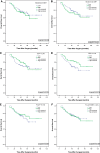Higher intratumoral infiltrated Foxp3+ Treg numbers and Foxp3+/CD8+ ratio are associated with adverse prognosis in resectable gastric cancer
- PMID: 20221835
- PMCID: PMC11828043
- DOI: 10.1007/s00432-010-0816-9
Higher intratumoral infiltrated Foxp3+ Treg numbers and Foxp3+/CD8+ ratio are associated with adverse prognosis in resectable gastric cancer
Abstract
Purpose: The aim of the present study was to investigate the prognostic value of tumor-infiltrated lymphocytes (TILs), especially the prognostic value of Foxp3+ regulatory T cells (Tregs), CD8+ CTLs and Tregs/CD8+ ratios in gastric cancer patients after R0 resection.
Patients and methods: From 133 patients, CD4+, CD8+ and Foxp3+ TILs were assessed by immunohistochemistry in tissue microarrays and N1 regional lymph nodes sections containing gastric cancer. The prognostic effects of low- or high-density TIL subsets were evaluated by Cox regression and Kaplan-Meier analysis using median values as cutoff, while the effects of Foxp3+/CD8+ ratios were evaluated using the value determined by ROC cure analysis as cutoff.
Results: It was found that CD4+ and CD8+ TILs were not associated with overall survival (OS). In the tumor sites, higher Foxp3+ Tregs/CD8+ ratio was an independent factor for worse OS (multivariate analysis HR = 2.827, P = 0.037). The 1-year, 2-year and 3-year OS rates were 90, 77.5 and 70% for the group with intratumoral high Tregs/CD8+ ratio, compared with 100, 94.3 and 90.5% for the group with intratumoral low ratio. At the same time, the presence of intratumoral high Foxp3+ Tregs was also associated with worse OS (log rank test, P = 0.025); however, it was not an independent predictor and correlated with intratumoral Foxp3+ Tregs/CD8+ ratio (chi(2) test, P < 0.001). Although the infiltration of Foxp3+ Tregs in N1 regional lymph nodes was associated with lymph node metastasis (P = 0.028), it was not associated with prognosis (P = 0.458).
Conclusions: Intratumoral high Foxp3+ Tregs/CD8+ ratio was an independent predictor for the prognosis of gastric cancer. It can be inferred that a combination of deletion of Tregs and stimulation of CD8+ effector T cells may be an effective immunotherapy to prolong survival after surgery.
Figures




Similar articles
-
The appearance of Tregs in cancer nest is a promising independent risk factor in colon cancer.J Cancer Res Clin Oncol. 2013 Nov;139(11):1845-52. doi: 10.1007/s00432-013-1500-7. Epub 2013 Sep 5. J Cancer Res Clin Oncol. 2013. PMID: 24005418 Free PMC article.
-
Worse outcome in breast cancer with higher tumor-infiltrating FOXP3+ Tregs : a systematic review and meta-analysis.BMC Cancer. 2016 Aug 26;16(1):687. doi: 10.1186/s12885-016-2732-0. BMC Cancer. 2016. PMID: 27566250 Free PMC article.
-
Comparison of Two Modern Survival Prediction Tools, SORG-MLA and METSSS, in Patients With Symptomatic Long-bone Metastases Who Underwent Local Treatment With Surgery Followed by Radiotherapy and With Radiotherapy Alone.Clin Orthop Relat Res. 2024 Dec 1;482(12):2193-2208. doi: 10.1097/CORR.0000000000003185. Epub 2024 Jul 23. Clin Orthop Relat Res. 2024. PMID: 39051924
-
The prognostic values of FOXP3+ tumor-infiltrating T cells in breast cancer: a systematic review and meta-analysis.Clin Transl Oncol. 2023 Jun;25(6):1830-1843. doi: 10.1007/s12094-023-03080-1. Epub 2023 Jan 24. Clin Transl Oncol. 2023. PMID: 36692642
-
Cost-effectiveness of using prognostic information to select women with breast cancer for adjuvant systemic therapy.Health Technol Assess. 2006 Sep;10(34):iii-iv, ix-xi, 1-204. doi: 10.3310/hta10340. Health Technol Assess. 2006. PMID: 16959170
Cited by
-
Foxp3 expression is associated with aggressiveness in differentiated thyroid carcinomas.Clinics (Sao Paulo). 2012;67(5):483-8. doi: 10.6061/clinics/2012(05)13. Clinics (Sao Paulo). 2012. PMID: 22666793 Free PMC article.
-
Therapeutic cancer vaccines in prostate cancer: the quest for intermediate markers of response.Cancers (Basel). 2012 Nov 22;4(4):1229-46. doi: 10.3390/cancers4041229. Cancers (Basel). 2012. PMID: 24213505 Free PMC article.
-
mRNA Expression levels of genes involved in antitumor immunity: Identification of a 3-gene signature associated with prognosis of muscle-invasive bladder cancer.Oncoimmunology. 2017 Aug 14;6(11):e1358330. doi: 10.1080/2162402X.2017.1358330. eCollection 2017. Oncoimmunology. 2017. PMID: 29147616 Free PMC article.
-
Tryptophan and its metabolites in normal physiology and cancer etiology.FEBS J. 2023 Jan;290(1):7-27. doi: 10.1111/febs.16245. Epub 2021 Nov 7. FEBS J. 2023. PMID: 34687129 Free PMC article. Review.
-
Tumor infiltration by Tbet+ effector T cells and CD20+ B cells is associated with survival in gastric cancer patients.Oncoimmunology. 2015 Jun 3;5(2):e1054598. doi: 10.1080/2162402X.2015.1054598. eCollection 2016 Feb. Oncoimmunology. 2015. PMID: 27057426 Free PMC article.
References
-
- Alvaro T, Lejeune M, Salvado MT et al (2005) Outcome in Hodgkin’s lymphoma can be predicted from the presence of accompanying cytotoxic and regulatory T cells. Clin Cancer Res 11:1467–1473 - PubMed
-
- Amy B, Heimberger, Mohamed AG et al (2008) Incidence and prognostic impact of Foxp3+ regulatory T cells in human gliomas. Clin Cancer Res 14:5166–5172 - PubMed
-
- Badoual C, Hans S, Rodriguez J et al (2006) Prognostic value of tumor-infiltrating CD4+ T-cell subpopulations in head and neck cancers. Clin Cancer Res 12:465–472 - PubMed
-
- Bates GJ, Fox SB, Han C et al (2006) Quantification of regulatory T cells enables the identification of high-risk breast cancer patients and those at risk of late relapse. J Clin Oncol 24:5373–5380 - PubMed
-
- Chiou SH, Sheu BC, Chang WC et al (2005) Current concepts of tumor-infiltrating lymphocytes in human malignancies. J Reprod Immunol 67:35–50 - PubMed
Publication types
MeSH terms
Substances
LinkOut - more resources
Full Text Sources
Other Literature Sources
Medical
Research Materials

